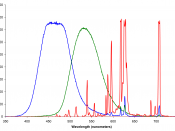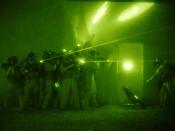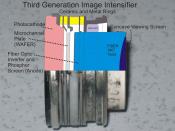Night Vision
When a soldier can pinpoint a target in the middle of the night with no visible light to the eye it provides a great advantage over the enemy target. Being able to see in the dark can also come in handy for non-military purposes. Night vision devices come in two basic forms: thermal imaging systems and image enhancement systems. Thermal imaging systems create various types of images from the heat given off by objects, also known as infrared light. The best of these devices can provide useful pictures of people from as far away as 1000 feet. You may have seen videos from such a system on police chase TV shows if a suspect was being chased through the woods or an area where light was very limited.
When most military personnel refer to "NVDs" (Night Vision Devices), however, they're referring to the image enhancement type.
Like the name says, this system amplifies existing visible light, and does a pretty impressive job, too. They can turn imperceptibly tiny amounts of light into usable images in almost complete darkness.
Visible light consists of particles called photons. More photons means more light. The main part of these NVD's is a component called an image-intensifier tube. In most NVD's, the power supply for the image-intensifier tube receives power from the two N-Cell or AA batteries. The output is about 5,000 volts. The first thing it does is convert the tiny amount of light present which are photons into electricity or electrons using a cathode. A cathode is a device that emits electricity when exposed to light.
The next thing that goes on in the image-intensifier tube is the multiplication of the electrons that represent the dark image. There are lots of ways to amplify an electrical signal, but NVD's...



Really intense
This is a professional-sounding paper and gives lots of facts.
1 out of 1 people found this comment useful.